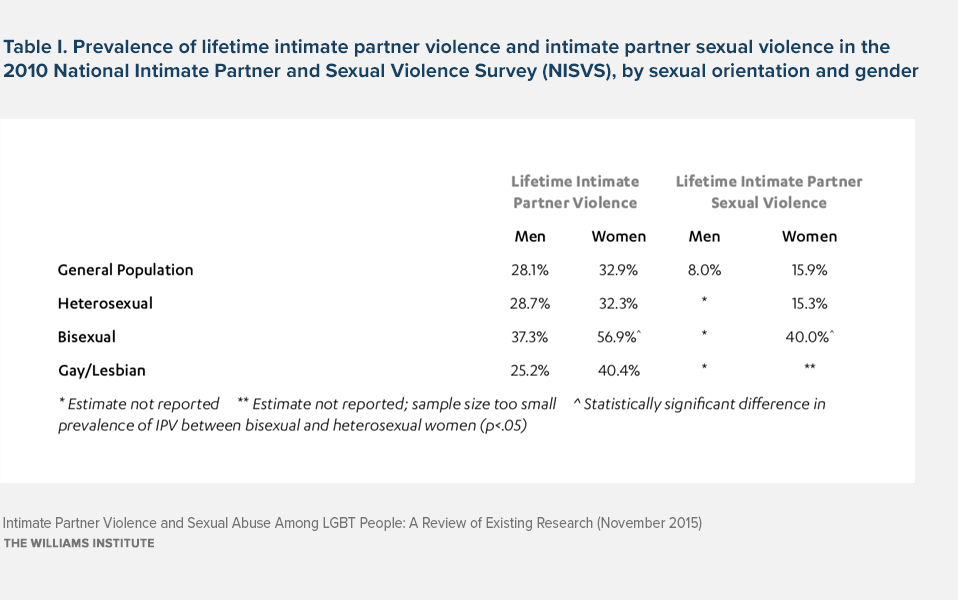Executive Summary
This report provides an overview of existing research on intimate partner violence (IPV) and sexual abuse (IPSA) among lesbian, gay, bisexual, and transgender (LGBT) people and makes recommendations for future research.
We reviewed 42 studies, from 1989 to the present, that include findings on the prevalence of IPV and IPSA, survivors’ barriers to seeking help, and the quality of available assistance for LGBT people. Most studies reviewed for this report found a lifetime prevalence of IPV among lesbian and bisexual women, gay and bisexual men, and transgender people that is as high as or higher than the U.S. general population. Key findings from this review include the following:
Sexual Minority Women
- According to the CDC’s National Intimate Partner and Sexual Violence Survey (NISVS), there is a higher prevalence of lifetime experiences of IPV among bisexual women than heterosexual women (Walters et al, 2013). Bisexual women are 1.8 times more likely to report ever having experienced IPV than heterosexual women (see Table I). Though the reported lifetime prevalence of IPV among lesbians is higher than heterosexual women, this is not a statistically significant difference.
- According to the NISVS, bisexual women are 2.6 times more likely to report ever having experienced intimate partner sexual violence compared to heterosexual women.
- One study estimated that 3.6% of lesbian women had experienced IPSA in their lifetimes (Messinger, 2011).
- Men and women both contribute to the prevalence of IPV among sexual minority women. For example, the CDC found that 89.5% of bisexual women reported only male perpetrators of intimate partner physical violence, rape, and/or stalking and that almost a third of lesbian women who have experienced such incidents have had one or more male perpetrators.
Sexual Minority Men
- According to the NISVS, bisexual men seem more likely to report ever having experienced IPV than heterosexual men, and gay men seem less likely than heterosexual men to report ever having experienced IPV. However, these differences are not statistically significant.
- One study that used a representative sample estimated that 26.9% of gay men had experienced IPV in their lifetimes and 12.1% had experienced IPV in the past year (Goldberg et al, 2013).
- Another study estimated a lifetime prevalence of IPSA among sexual minority men of 3.1% among gay men, as well as among bisexual men and MSM (Messinger, 2011).
Transgender People
- Although more limited in number, studies suggest that transgender people may confront similar levels, if not higher levels, of IPV as compared to sexual minority men and women and cisgender people. Findings of lifetime IPV among transgender people from purposive studies range from 31.1%to 50.0%.
- Only one study directly compared the lifetime prevalence of IPV among transgender and cisgender people. This study found that 31.1% of transgender people and 20.4% of cisgender people had ever experienced IPV or dating violence (Langenderfer-Magruder, 2014).
- Three studies provided findings of lifetime IPSA prevalence among transgender people, which range from 25.0% to 47.0%.
Barriers to Assistance
- Research shows that LGBT people face barriers to seeking help that are unique to their sexual orientation and gender identity. These include:
- Legal definitions of domestic violence that exclude same-sex couples
- Dangers of “outing” oneself when seeking help and the risk of rejection and isolation from family, friends, and society
- The lack of, or survivors not knowing about, LGBT-specific or LGBT-friendly assistance resources
- Potential homophobia from staff of service providers or from non-LGBT survivors of IPV and IPSA with whom they may interact
- Low levels of confidence in the sensitivity and effectiveness of law enforcement officials and courts for LGBT people
Quality of Help
- Individual Counselors: A number of studies showed that LGBT survivors found individual counselors to be particularly helpful. For example, respondents to one survey identified counselors as the most needed service, and among those who spoke with counselors, nearly 90% found them to be helpful (Turrell, 2000a).
- Shelters: Studies suggest that some sexual minority men and women do not believe shelters to be helpful. LGBT survivors may fear homophobia at shelters, and sexual minority men and transgender people may be concerned that shelters are not open to them.
- Health Care Providers: Studies suggest that LGBT survivors have low confidence in health care providers’ ability to help. Some transgender people have reported that their health care providers lack competency on transgender issues. Therefore, transgender people may have particular difficulty seeking help for IPV and IPSA from health care providers.
- Law Enforcement: LGBT people frequently cite law enforcement as unhelpful sources of assistance in addressing cases of IPV and IPSA.
Further Research
The studies reviewed for this report also point to certain topics and considerations for future research.
- There is limited research in this field that uses randomly-selected, representative samples. Including questions about individuals’ sexual orientation (such as has been done in the NISVS) and gender identity in these types of national and state-level surveys would advance our understanding of IPV and IPSA among LGBT people by providing more generalizable findings.
- While, overall, research about the prevalence, effects, and other aspects of IPV and IPSA among LGBT people is lacking, a very limited number of studies in this field is devoted solely to transgender people. Researchers should consider studies that focus on prevalence, effects, risk factors, and help-seeking related to IPV and IPSA among transgender people.
- Researchers should consider studies that evaluate the effectiveness of programs devoted to reducing the prevalence of IPV and IPSA among LGBT people and programs that assist LGBT survivors.
Further research into these areas will help researchers and service providers in developing studies and programs that more effectively address LGBT IPV and IPSA.
Download the full report
